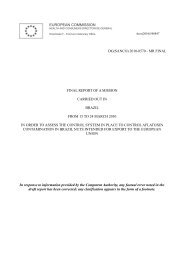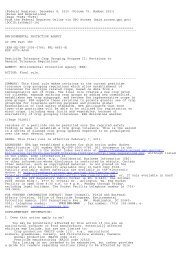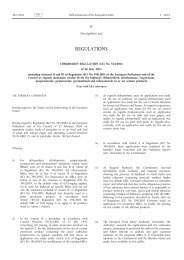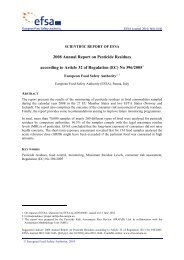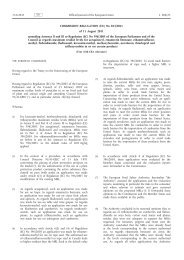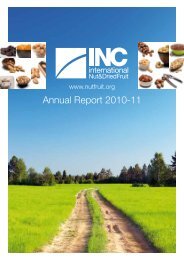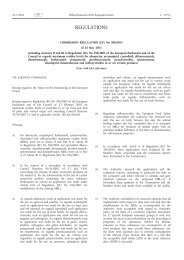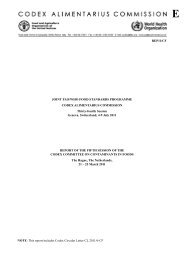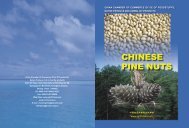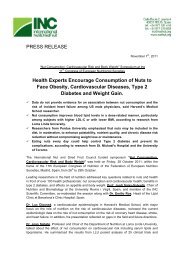final report of a mission carried out in iran from 11 to 20 october ...
final report of a mission carried out in iran from 11 to 20 october ...
final report of a mission carried out in iran from 11 to 20 october ...
You also want an ePaper? Increase the reach of your titles
YUMPU automatically turns print PDFs into web optimized ePapers that Google loves.
Ref. Ares(<strong>20</strong><strong>11</strong>)124402 - 04/02/<strong>20</strong><strong>11</strong>EUROPEAN COMMISSIONHEALTH AND CONSUMERS DIRECTORATE-GENERALDirec<strong>to</strong>rate F - Food and Veter<strong>in</strong>ary OfficeDG(SANCO) <strong>20</strong>10-8594 - MR FINALFINAL REPORT OF A MISSIONCARRIED OUT INIRANFROM <strong>11</strong> TO <strong>20</strong> OCTOBER <strong>20</strong>10IN ORDER TO ASSESS THE CONTROL SYSTEM IN PLACE TO CONTROL AFLATOXINCONTAMINATION IN PISTACHIO NUTS INTENDED FOR EXPORT TO THE EUROPEANUNION AND TO FOLLOW UP THE RECOMMENDATIONS OF MISSION DG SANCO7670/<strong>20</strong>05In response <strong>to</strong> <strong>in</strong>formation provided by the Competent Authority, any factual error noted <strong>in</strong> thedraft <strong>report</strong> has been corrected; any clarification appears <strong>in</strong> the form <strong>of</strong> a footnote.
Executive SummaryThis <strong>report</strong> describes the <strong>out</strong>come <strong>of</strong> a <strong>mission</strong> <strong>carried</strong> <strong>out</strong> by the Food and Veter<strong>in</strong>ary Office(FVO) <strong>in</strong> the Islamic Republic <strong>of</strong> Iran <strong>from</strong> <strong>11</strong> <strong>to</strong> <strong>20</strong> Oc<strong>to</strong>ber <strong>20</strong>10.The objective was <strong>to</strong> assess the control systems <strong>in</strong> place <strong>to</strong> control afla<strong>to</strong>x<strong>in</strong> contam<strong>in</strong>ation <strong>in</strong>pistachio nuts <strong>in</strong>tended for export <strong>to</strong> the European Union (EU) and the action taken by thecompetent authorities (CAs) <strong>in</strong> response <strong>to</strong> the recommendations made by the FVO <strong>in</strong> <strong>report</strong>SANCO 7670/<strong>20</strong>05.No major changes have been made <strong>in</strong> the responsibilities for controls on pistachio exports <strong>to</strong> theEU. S<strong>in</strong>ce the last <strong>mission</strong> progress has been made on adopt<strong>in</strong>g new requirements and proceduresfor <strong>of</strong>ficial controls, <strong>in</strong> particular regard<strong>in</strong>g sampl<strong>in</strong>g <strong>of</strong> exports <strong>to</strong> the EU, registration <strong>of</strong> foodestablishments, food hygiene requirements and HACCP. Tangible progress has been made onimplement<strong>in</strong>g good practices <strong>in</strong> pistachio cultivation and process<strong>in</strong>g.Pistachios for export <strong>to</strong> the EU market could still orig<strong>in</strong>ate <strong>from</strong> farms that are not implement<strong>in</strong>ggood agricultural practices (GAP) and do not apply the pr<strong>in</strong>ciples <strong>of</strong> <strong>in</strong>tegrated pest management(IPM). The level <strong>of</strong> HACCP implementation by the pistachio processors export<strong>in</strong>g <strong>to</strong> the EU islow.Despite all the efforts made, the number <strong>of</strong> consignments <strong>of</strong> pistachios not comply<strong>in</strong>g with the EUlimits on afla<strong>to</strong>x<strong>in</strong>s, whether presented <strong>in</strong> Iran for export <strong>to</strong> the EU or at EU borders for import, isstill high, add<strong>in</strong>g up <strong>to</strong>gether <strong>to</strong> over <strong>20</strong> % (<strong>20</strong>09 data). The current system <strong>of</strong> sanctions aga<strong>in</strong>stexporters who try <strong>to</strong> export consignments that are not <strong>in</strong> compliance with the legal requirements onafla<strong>to</strong>x<strong>in</strong>s is not effective, as it takes no account <strong>of</strong> the pre-export rejection rate.Considerable improvements have been made s<strong>in</strong>ce the last <strong>mission</strong> at all the labora<strong>to</strong>ries visitedregard<strong>in</strong>g their quality management system and quality controls. However, accreditation <strong>of</strong> all<strong>of</strong>ficial labora<strong>to</strong>ries is still lack<strong>in</strong>g. In addition, certa<strong>in</strong> aspects identified <strong>in</strong> the labora<strong>to</strong>ries’performance still do not comply with the criteria established by Regulation (EC) No 401/<strong>20</strong>06.Overall, good procedures are <strong>in</strong> place for <strong>of</strong>ficial controls on pistachios <strong>in</strong>tended for export <strong>to</strong> theEU. Improvements have been made s<strong>in</strong>ce the last <strong>mission</strong> <strong>to</strong> rectify deficiencies <strong>in</strong> the procedures.However, there are still deficiencies, particularly <strong>in</strong> labora<strong>to</strong>ry accreditation and application <strong>of</strong> thecriteria established by Regulation (EC) No 401/<strong>20</strong>06. Although good progress has been made s<strong>in</strong>cethe last <strong>mission</strong> on implementation <strong>of</strong> GAP, IPM and Good Manufactur<strong>in</strong>g Practice (GMP) <strong>in</strong>pistachio cultivation and process<strong>in</strong>g, further efforts are needed <strong>to</strong> reduce the number <strong>of</strong>consignments <strong>of</strong> pistachios <strong>in</strong>tended for export <strong>to</strong> the EU which do not comply with the EU limitson afla<strong>to</strong>x<strong>in</strong>s.This <strong>report</strong> conta<strong>in</strong>s recommendations <strong>to</strong> the CAs <strong>of</strong> the Islamic Republic <strong>of</strong> Iran with the aim <strong>of</strong>address<strong>in</strong>g the shortcom<strong>in</strong>gs identified.I
Table <strong>of</strong> Contents1 INTRODUCTION........................................................................................................................12 OBJECTIVES OF THE MISSION.................................................................................................13 LEGAL BASIS FOR THE MISSION................................................................................................23.1 LEGAL BASIS FOR THE MISSION ........................................................................................................23.2 LEGAL STANDARDS .......................................................................................................................24 BACKGROUND..........................................................................................................................34.1 FVO MISSIONS TO THIRD COUNTRIES REGARDING MYCOTOXIN CONTAMINATION IN FOODSTUFFS .................34.2 BACKGROUND TO THE MISSION ........................................................................................................35 FINDINGS AND CONCLUSIONS...................................................................................................45.1 RELEVANT NATIONAL LEGISLATION ...................................................................................................45.2 COMPETENT AUTHORITIES ...............................................................................................................55.2.1 COMPETENT AUTHORITIES........................................................................................................55.2.2 CUSTOMS AUTHORITIES ...........................................................................................................65.2.3 OTHER ORGANISATIONS ...........................................................................................................65.3 CONTROLS ALONG THE PISTACHIO NUT PRODUCTION AND PROCESSING CHAIN IN IRAN ...............................75.3.1 PISTACHIO NUT CULTIVATION ....................................................................................................75.3.2 PISTACHIO NUT PROCESSING .....................................................................................................85.3.3 NON-CONFORMING PRODUCTS ..................................................................................................95.3.4 ADDITIONAL PRIVATE CONTROLS ................................................................................................95.4 METHOD OF SAMPLING PISTACHIO NUT CONSIGNMENTS ......................................................................105.4.1 SAMPLING PROCEDURE .........................................................................................................105.5 PROCEDURE FOR EXPORTING PISTACHIO NUTS TO THE EU ..................................................................<strong>11</strong>5.6 LABORATORY SERVICES ................................................................................................................125.6.1 LABORATORIES VISITED .........................................................................................................125.7 RESPONSE TO RASFF NOTIFICATIONS ...........................................................................................145.8 FOLLOW-UP TO PREVIOUS MISSION .................................................................................................156 OVERALL CONCLUSIONS.........................................................................................................167 CLOSING MEETING................................................................................................................168 RECOMMENDATIONS...............................................................................................................16ANNEX 1 - LEGAL REFERENCES.................................................................................................18II
ABBREVIATIONS AND DEFINITIONS USED IN THIS REPORTAbbreviationAOACBCCACAC/RCPCCACNEUFCLFDCLFDOFVOGAPGMPGSPHACCPHPLCIPAIPMIPRIISIRIISOMoAMOHMEMSNSPCRASFFSANCO (DG)SOPTCUExplanationAssociation <strong>of</strong> Official Analytical ChemistsBlue CorridorCompetent AuthorityCodex Alimentarius Committee/Recommended Code <strong>of</strong> PracticeCentral Competent AuthorityComb<strong>in</strong>ed NomenclatureEuropean UnionFood Control Labora<strong>to</strong>ryFood and Drug Control Labora<strong>to</strong>ryFood and Drug OfficeFood and Veter<strong>in</strong>ary OfficeGood Agricultural PracticeGood Manufactur<strong>in</strong>g PracticeGood S<strong>to</strong>rage PracticeHazard Analysis and Critical Control Po<strong>in</strong>tsHigh Performance Liquid Chroma<strong>to</strong>graphyIran Pistachio AssociationIntegrated Pest ManagementIran Pistachio Research InstituteInstitute <strong>of</strong> Standards and Industrial Research <strong>of</strong> IranInternational Organisation for StandardisationM<strong>in</strong>istry <strong>of</strong> Agriculture <strong>of</strong> JihadM<strong>in</strong>istry <strong>of</strong> Health and Medical EducationMember StateNational Supreme Pistachio CouncilRapid Alert System for Food and FeedHealth and Consumers Direc<strong>to</strong>rate-GeneralStandard Operat<strong>in</strong>g ProcedureThird CountryMeasurement uncerta<strong>in</strong>tyIII
1INTRODUCTIONThe <strong>mission</strong> <strong>to</strong>ok place <strong>in</strong> the Islamic Republic <strong>of</strong> Iran (here<strong>in</strong>after referred <strong>to</strong> as ‘Iran’) <strong>from</strong> <strong>11</strong> <strong>to</strong><strong>20</strong> Oc<strong>to</strong>ber <strong>20</strong>10 <strong>in</strong> order <strong>to</strong> assess the control systems <strong>in</strong> place <strong>to</strong> prevent afla<strong>to</strong>x<strong>in</strong> contam<strong>in</strong>ation<strong>in</strong> pistachio nuts <strong>in</strong>tended for export <strong>to</strong> the EU. The <strong>mission</strong> team consisted <strong>of</strong> two <strong>in</strong>spec<strong>to</strong>rs <strong>from</strong>the Food and Veter<strong>in</strong>ary Office (FVO) and one Member State (MS) expert .The <strong>mission</strong> was undertaken as part <strong>of</strong> the FVO’s annual <strong>mission</strong> programme <strong>in</strong> order <strong>to</strong> follow updevelopments <strong>in</strong> Iran s<strong>in</strong>ce the previous FVO <strong>mission</strong> (SANCO 7670/<strong>20</strong>05).Dur<strong>in</strong>g the <strong>mission</strong> the <strong>in</strong>spection team was accompanied by the representative <strong>of</strong> the centralcompetent authority (CCA), the M<strong>in</strong>istry <strong>of</strong> Agriculture <strong>of</strong> Jihad (MoA).An open<strong>in</strong>g meet<strong>in</strong>g was held on <strong>11</strong> Oc<strong>to</strong>ber <strong>20</strong>10 with the CCA (MoA), <strong>in</strong>clud<strong>in</strong>g therepresentatives <strong>of</strong> the M<strong>in</strong>istry <strong>of</strong> Health and Medical Education (MOHME), the Institute <strong>of</strong>Standards and Industrial Research <strong>of</strong> Iran (ISIRI), the Iran Cus<strong>to</strong>ms Agency, the Iran Port Authority,the Iran Chamber <strong>of</strong> Commerce, Industry and M<strong>in</strong>es, Iran Pistachio Association (IPA) and KermanChamber <strong>of</strong> Commerce. At this meet<strong>in</strong>g, the objectives <strong>of</strong> and it<strong>in</strong>erary for the <strong>mission</strong> wereconfirmed.2 OBJECTIVES OF THE MISSIONThe objectives <strong>of</strong> the <strong>mission</strong> were <strong>to</strong>:– verify whether the control systems are <strong>in</strong> place <strong>to</strong> control afla<strong>to</strong>x<strong>in</strong> contam<strong>in</strong>ation <strong>in</strong> pistachio nuts<strong>in</strong>tended for export <strong>to</strong> the European Union with<strong>in</strong> specified European Union (EU) contam<strong>in</strong>antlimits, comply<strong>in</strong>g with or be<strong>in</strong>g at least equivalent <strong>to</strong> Com<strong>mission</strong> Regulation (EC) No 1881/<strong>20</strong>06.– assess compliance with conditions <strong>in</strong> Com<strong>mission</strong> Regulation (EC) No <strong>11</strong>52/<strong>20</strong>09 on specialconditions govern<strong>in</strong>g certa<strong>in</strong> foodstuffs imported <strong>from</strong> certa<strong>in</strong> third countries (TC) due <strong>to</strong>contam<strong>in</strong>ation risks <strong>of</strong> these products by afla<strong>to</strong>x<strong>in</strong>s;– follow up recommendations made <strong>in</strong> the previous <strong>report</strong> (SANCO 7670/<strong>20</strong>05).In terms <strong>of</strong> scope, the <strong>mission</strong> reviewed the controls <strong>in</strong> place on production and exports, <strong>in</strong>clud<strong>in</strong>gthe national legislation <strong>in</strong> place, organisation <strong>of</strong> the competent authorities (CA) and their controlsand enforcement capability.In pursuit <strong>of</strong> this objective, the follow<strong>in</strong>g sites were visited :COMPETENT AUTHORITY/IESCentral Competent Authorities 3 MoAMOHMEIran Cus<strong>to</strong>ms AgencyCommentsRegional/local Competent Authorities 2 Food and Drug Office (FDO) <strong>of</strong> the MOHME,KermanFDO <strong>of</strong> the MOHME, RafsanjanLabora<strong>to</strong>ries 3 Food and Drug Control Labora<strong>to</strong>ry (FDCL),1
TehranFood Control Labora<strong>to</strong>ry (FCL), KermanFCL, RafsanjanPRODUCERS5 One pistachio orchard <strong>in</strong> RafsanjanFour pistachio orchards <strong>in</strong> KermanPROCESSORS5 Three pistachio processors <strong>in</strong> RafsanjanTwo pistachio processors <strong>in</strong> KermanPOINTS OF EXPORTOTHER SITE VISITS/MEETINGS1 Kerman cus<strong>to</strong>ms <strong>of</strong>fice1 Chamber <strong>of</strong> Commerce <strong>in</strong> Kerman3 LEGAL BASIS FOR THE MISSION3.1 LEGAL BASIS FOR THE MISSIONThe <strong>mission</strong> was <strong>carried</strong> <strong>out</strong> under the general provisions <strong>of</strong> Community legislation, <strong>in</strong> particularArticle 46 <strong>of</strong> Regulation (EC) No 882/<strong>20</strong>04 <strong>of</strong> the European Parliament and <strong>of</strong> the Council whichstipulates that Community controls <strong>in</strong> TCs may verify the compliance or equivalence <strong>of</strong> TClegislation and systems with Community feed and food law and Community animal healthlegislation. These controls must have particular regard <strong>to</strong> the assurances which the TC can giveregard<strong>in</strong>g compliance with, or equivalence <strong>to</strong>, Community requirements.3.2 LEGAL STANDARDSArticle <strong>11</strong> <strong>of</strong> Regulation (EC) No 178/<strong>20</strong>02 stipulates that food and feed imported <strong>in</strong><strong>to</strong> theCommunity for plac<strong>in</strong>g on the market with<strong>in</strong> the Community shall comply with the relevantrequirements <strong>of</strong> food law or conditions recognised by the Community <strong>to</strong> be at least equivalentthere<strong>to</strong>.Article 10 <strong>of</strong> Regulation (EC) No 852/<strong>20</strong>04 stipulates that as regards the hygiene <strong>of</strong> imported food,the relevant requirements <strong>of</strong> food law referred <strong>to</strong> <strong>in</strong> Article <strong>11</strong> <strong>of</strong> Regulation (EC) No 178/<strong>20</strong>02shall <strong>in</strong>clude the requirements laid down <strong>in</strong> Articles 3 <strong>to</strong> 6 <strong>of</strong> the Regulation.Annex <strong>to</strong> Regulation (EC) No 1881/<strong>20</strong>06 sets <strong>out</strong> maximum levels for myco<strong>to</strong>x<strong>in</strong>s <strong>in</strong> foodstuffs.Com<strong>mission</strong> Regulation (EC) No 401/<strong>20</strong>06 lays down the methods <strong>of</strong> sampl<strong>in</strong>g and analysis for the<strong>of</strong>ficial controls <strong>of</strong> the levels <strong>of</strong> myco<strong>to</strong>x<strong>in</strong>s <strong>in</strong> foodstuffs.Reference is also made <strong>to</strong> the follow<strong>in</strong>g Codex Alimentarius standards:Code <strong>of</strong> Practice for the Prevention and Reduction <strong>of</strong> Afla<strong>to</strong>x<strong>in</strong> Contam<strong>in</strong>ation <strong>in</strong> Tree Nuts(CAC/RCP 59-<strong>20</strong>05, Rev.1-<strong>20</strong>06).2
Guidel<strong>in</strong>es for the Design, Operation, Assessment and Accreditation <strong>of</strong> Food Import and ExportInspection and Certification Systems (Codex Alimentarius CAC/GL 26-1997).Guidel<strong>in</strong>es for the Assessment <strong>of</strong> the Competence <strong>of</strong> test<strong>in</strong>g labora<strong>to</strong>ries <strong>in</strong>volved <strong>in</strong> the import andexport control <strong>of</strong> food (Codex Alimentarius CAC/GL 27-1997).A full list <strong>of</strong> the legal <strong>in</strong>struments referred <strong>to</strong> <strong>in</strong> this <strong>report</strong> is provided <strong>in</strong> Annex 1. Legal acts quoted<strong>in</strong> this <strong>report</strong> refer, where applicable, <strong>to</strong> the most recently amended version.4 BACKGROUND4.1 FVO MISSIONS TO THIRD COUNTRIES REGARDING MYCOTOXIN CONTAMINATION IN FOODSTUFFSThe European Com<strong>mission</strong> carries <strong>out</strong> <strong>mission</strong>s <strong>to</strong> the ma<strong>in</strong> export<strong>in</strong>g countries <strong>to</strong> evaluate their<strong>of</strong>ficial control systems for prevent<strong>in</strong>g afla<strong>to</strong>x<strong>in</strong> contam<strong>in</strong>ation <strong>in</strong> foodstuffs orig<strong>in</strong>at<strong>in</strong>g <strong>from</strong> thosecountries. This is the fourth <strong>mission</strong> <strong>to</strong> Iran concern<strong>in</strong>g afla<strong>to</strong>x<strong>in</strong>s <strong>in</strong> pistachio nuts. The <strong>report</strong>s onearlier <strong>mission</strong>s are available on DG SANCO’s website at:http://ec.europa.eu/food/fvo/ir_search_en.cfm .4.2 BACKGROUND TO THE MISSIONNotifications concern<strong>in</strong>g foodstuffs found <strong>to</strong> have public health implications are dissem<strong>in</strong>ated <strong>to</strong> allMSs and <strong>to</strong> the export<strong>in</strong>g country via the Rapid Alert System for Food and Feed (RASFF). In thecase <strong>of</strong> pistachios, the notifications <strong>in</strong>dicate myco<strong>to</strong>x<strong>in</strong> contents exceed<strong>in</strong>g the EU limits <strong>of</strong> 8 ppbfor afla<strong>to</strong>x<strong>in</strong> B1 and 10 ppb for <strong>to</strong>tal afla<strong>to</strong>x<strong>in</strong>s <strong>in</strong> nuts for direct human consumption. S<strong>in</strong>ce theprevious FVO <strong>mission</strong> (SANCO 7670/<strong>20</strong>05), some 625 alerts relat<strong>in</strong>g <strong>to</strong> afla<strong>to</strong>x<strong>in</strong>s <strong>in</strong> pistachios<strong>from</strong> Iran have been issued via the RASFF (234 <strong>in</strong> <strong>20</strong>06, 126 <strong>in</strong> <strong>20</strong>07, 158 <strong>in</strong> <strong>20</strong>08, 57 <strong>in</strong> <strong>20</strong>09 and50 dur<strong>in</strong>g the first eight months <strong>of</strong> <strong>20</strong>10). The breakdown <strong>of</strong> these alerts and the volume <strong>of</strong> imports<strong>in</strong><strong>to</strong> the EU are shown <strong>in</strong> Table. The biggest import<strong>in</strong>g Member States are <strong>in</strong>dicated <strong>in</strong> brackets.Regulation (EC) No <strong>11</strong>52/<strong>20</strong>09 imposes specific import conditions on products <strong>from</strong> certa<strong>in</strong> TCswhere the risk <strong>of</strong> contam<strong>in</strong>ation is considered greatest. These specific conditions relate <strong>to</strong>myco<strong>to</strong>x<strong>in</strong> contam<strong>in</strong>ation, <strong>in</strong>clud<strong>in</strong>g checks on the afla<strong>to</strong>x<strong>in</strong> content <strong>of</strong> pistachio nuts orig<strong>in</strong>at<strong>in</strong>g <strong>in</strong>or consigned <strong>from</strong> Iran and <strong>in</strong>tended for import <strong>in</strong><strong>to</strong> the EU. Under Regulation (EC) No <strong>11</strong>52/<strong>20</strong>09,pistachios exported <strong>to</strong> the EU have <strong>to</strong> be accompanied by a health certificate issued by the MOHMEconfirm<strong>in</strong>g that the consignment was sampled and analysed for afla<strong>to</strong>x<strong>in</strong>s <strong>in</strong> accordance withCom<strong>mission</strong> Regulation (EC) No 401/<strong>20</strong>06. MSs are required <strong>to</strong> perform documentary checks andfurther sampl<strong>in</strong>g and analysis <strong>of</strong> 50 % <strong>of</strong> the consignments for afla<strong>to</strong>x<strong>in</strong> B1 and <strong>to</strong>tal afla<strong>to</strong>x<strong>in</strong>s atthe po<strong>in</strong>t <strong>of</strong> entry s<strong>in</strong>ce <strong>20</strong>10 (before <strong>20</strong>10, sampl<strong>in</strong>g and analysis frequency <strong>of</strong> 100 % wasapplicable). Any non-compliance found results <strong>in</strong> rejection <strong>of</strong> the consignment <strong>from</strong> enter<strong>in</strong>g thecommon market and, subsequently, <strong>in</strong> return <strong>to</strong> the place <strong>of</strong> orig<strong>in</strong> or another TC or destruction <strong>of</strong>the consignment.Imports <strong>to</strong> the EU (metric <strong>to</strong>nnes)Number <strong>of</strong> RASFF notifications<strong>20</strong>08 <strong>20</strong>09 <strong>20</strong>06 <strong>20</strong>07 <strong>20</strong>08 <strong>20</strong>09 <strong>20</strong>10(8 months)Pistachios(CN code0802 50 00)26 600(BE, NL, DE)18 458(DE, BE)234 126 158 57 503
Source: Eurostat, Comext databaseIn view <strong>of</strong> the number <strong>of</strong> alerts, the FVO decided <strong>to</strong> undertake a <strong>mission</strong> with the abovementionedobjectives.The <strong>report</strong> on <strong>mission</strong> SANCO 7670/<strong>20</strong>05 conta<strong>in</strong>ed recommendations <strong>to</strong> the CAs <strong>of</strong> the country.The action plans subsequently received were considered satisfac<strong>to</strong>ry.5 FINDINGS AND CONCLUSIONS5.1 RELEVANT NATIONAL LEGISLATIONLegal requirementsArticle 46(1)(a) <strong>of</strong> Regulation (EC) No 882/<strong>20</strong>04 stipulates that Community controls must haveparticular regard, <strong>in</strong>ter alia, <strong>to</strong> the legislation <strong>of</strong> the TC.This <strong>mission</strong> covered the specific standards for the admissible levels <strong>of</strong> afla<strong>to</strong>x<strong>in</strong>s established <strong>in</strong>Regulation (EC) No 1881/<strong>20</strong>06 (as last amended) sett<strong>in</strong>g maximum levels for certa<strong>in</strong> contam<strong>in</strong>ants(<strong>in</strong>clud<strong>in</strong>g myco<strong>to</strong>x<strong>in</strong>s) <strong>in</strong> foodstuffs.Regulation 401/<strong>20</strong>06 (as amended) lays down the methods <strong>of</strong> sampl<strong>in</strong>g and analysis for the <strong>of</strong>ficialcontrol <strong>of</strong> the levels <strong>of</strong> myco<strong>to</strong>x<strong>in</strong>s <strong>in</strong> foodstuffs.F<strong>in</strong>d<strong>in</strong>gsThe follow<strong>in</strong>g changes have been made <strong>to</strong> the relevant national legislation s<strong>in</strong>ce the previous FVO<strong>mission</strong> (SANCO/7670/<strong>20</strong>05):• Iranian standard No 1<strong>20</strong>04 on sampl<strong>in</strong>g methods for the <strong>of</strong>ficial control <strong>of</strong> myco<strong>to</strong>x<strong>in</strong>s <strong>in</strong>foodstuffs is based on Com<strong>mission</strong> Regulation 401/<strong>20</strong>06. The <strong>mission</strong> team was <strong>in</strong>formedthat Com<strong>mission</strong> Regulation 178/<strong>20</strong>10 amend<strong>in</strong>g the abovementioned Regulation has notyet been <strong>in</strong>corporated <strong>in</strong><strong>to</strong> the abovementioned standard. Accord<strong>in</strong>g <strong>to</strong> the representatives <strong>of</strong>the Institute <strong>of</strong> Standards and Industrial Research <strong>of</strong> Iran (ISIRI), the abovementionednational standard is be<strong>in</strong>g revised and the new version will be adopted by mid-November<strong>20</strong>10. However, the <strong>mission</strong> team saw evidence that Regulation (EU) No 178/<strong>20</strong>10 has beentranslated <strong>in</strong><strong>to</strong> Farsi and made available <strong>to</strong> FDO <strong>in</strong>spec<strong>to</strong>rs. In addition, staff responsible for<strong>of</strong>ficial sampl<strong>in</strong>g under the abovementioned Regulation received tra<strong>in</strong><strong>in</strong>g <strong>in</strong> September <strong>20</strong>10<strong>in</strong> both regions visited. 1• The Iranian Cus<strong>to</strong>ms Tariff codes for the various types <strong>of</strong> pistachio for export have beenamended. Instead <strong>of</strong> the s<strong>in</strong>gle code 08025000, the follow<strong>in</strong>g five-code system is now used:− Code No 08025010 for ‘Different varieties <strong>of</strong> open <strong>in</strong>-shell pistachios’;− Code No 080250<strong>20</strong> for ‘Different varieties <strong>of</strong> closed <strong>in</strong>-shell pistachios’;− Code No 08025030 for ‘Pistachio kernels’;− Code No 08025040 for ‘Pistachio kernels with<strong>out</strong> endocarp’ (blanched, whole pistachiokernels) and ‘Pistachio kernel slivers’ (blanched pistachio kernel slivers);1 In their response <strong>to</strong> the draft <strong>report</strong> the Competent Authority noted that the national standard <strong>of</strong> “Sampl<strong>in</strong>g method<strong>of</strong> tree kernels” has been passed by the <strong>f<strong>in</strong>al</strong> Com<strong>mission</strong> <strong>of</strong> ISIRI (standard is based on the requirements <strong>of</strong>Regulation (EC) No 178/<strong>20</strong>10).4
− Code No 08025050 for ‘Other pistachio products’.• Directive No PEI/CRV1/0040 <strong>of</strong> the MOHME <strong>from</strong> <strong>20</strong>06 establishes the requirements forlicens<strong>in</strong>g food processors. Among other th<strong>in</strong>gs, they are required <strong>to</strong> comply with generalfood hygiene requirements.• The Decision <strong>of</strong> the National Supreme Pistachio Council <strong>of</strong> 27 September <strong>20</strong>10 requires thatall consignments <strong>in</strong>tended for export <strong>to</strong> the EU should be certified aga<strong>in</strong>st the afla<strong>to</strong>x<strong>in</strong>limits set <strong>in</strong> Regulation (EC) No 165/<strong>20</strong>10 (afla<strong>to</strong>x<strong>in</strong> B1: 8 ppb and <strong>to</strong>tal afla<strong>to</strong>x<strong>in</strong>s: 10 ppb).Until September <strong>20</strong>10, certification was based on the former afla<strong>to</strong>x<strong>in</strong> limits set <strong>in</strong>Regulation (EC) No 1881/<strong>20</strong>06 (2 ppb for B1 and 4 ppb for <strong>to</strong>tal afla<strong>to</strong>x<strong>in</strong>s).In addition <strong>to</strong> this legislation, the follow<strong>in</strong>g guidel<strong>in</strong>es are relevant <strong>to</strong> this <strong>mission</strong>:• ISIRI No 8914 <strong>from</strong> <strong>20</strong>06 on the ‘Code <strong>of</strong> practice for establish<strong>in</strong>g a HACCP system <strong>in</strong>pistachio process<strong>in</strong>g establishments’;• Good Agricultural Practice Guidel<strong>in</strong>es on pistachio cultivation (last amended <strong>in</strong> <strong>20</strong>09);• ISIRI No 8689 on the „Tree nuts-Code <strong>of</strong> hygienic practice‟No changes have been made <strong>to</strong> the national legislation with regard <strong>to</strong> the maximum limits forafla<strong>to</strong>x<strong>in</strong>s <strong>in</strong> pistachios for the domestic market. The limits for pistachios for direct humanconsumption are 5 ppb for afla<strong>to</strong>x<strong>in</strong> B1 and 15 ppb for <strong>to</strong>tal afla<strong>to</strong>x<strong>in</strong>s.ConclusionsS<strong>in</strong>ce the last <strong>mission</strong> progress has been made on adopt<strong>in</strong>g new requirements and procedures for<strong>of</strong>ficial controls: new legislation, standards and guidel<strong>in</strong>es have been <strong>in</strong>troduced cover<strong>in</strong>g sampl<strong>in</strong>gfor exports <strong>to</strong> the EU, registration <strong>of</strong> food establishments, food hygiene requirements and HACCP.5.2 COMPETENT AUTHORITIESLegal requirementsArticle 46(1)(b) <strong>of</strong> Regulation (EC) No 882/<strong>20</strong>04 stipulates that Community controls must haveparticular regard <strong>to</strong>, <strong>in</strong>ter alia , the organisation <strong>of</strong> the TC’s CAs, their powers and <strong>in</strong>dependenceand the authority they have <strong>to</strong> enforce the applicable legislation effectively.Article 46(1)(c) <strong>of</strong> Regulation (EC) No 882/<strong>20</strong>04 stipulates that Community controls must haveparticular regard <strong>to</strong> the tra<strong>in</strong><strong>in</strong>g <strong>of</strong> staff <strong>in</strong> the performance <strong>of</strong> <strong>of</strong>ficial controls.F<strong>in</strong>d<strong>in</strong>gs5.2.1 Competent AuthoritiesS<strong>in</strong>ce <strong>mission</strong> SANCO 7670/<strong>20</strong>05 the follow<strong>in</strong>g changes have been made <strong>to</strong> the responsibilities forsupervision and <strong>in</strong>spection <strong>of</strong> cultivation, process<strong>in</strong>g and export <strong>of</strong> pistachios:• The National Supreme Pistachio Council (NSPC) has been established as a nationwidecoord<strong>in</strong>at<strong>in</strong>g body for pistachio-related issues. Its ma<strong>in</strong> task is coord<strong>in</strong>ation between thedifferent m<strong>in</strong>istries, research bodies and entities <strong>in</strong>volved <strong>in</strong> production and export <strong>of</strong>pistachios. The NSPC has the same powers <strong>to</strong> the Council <strong>of</strong> M<strong>in</strong>isters as a M<strong>in</strong>ister and itsdecisions are legally b<strong>in</strong>d<strong>in</strong>g.5
• There has been some restructur<strong>in</strong>g with<strong>in</strong> the MoA with regard <strong>to</strong> pistachio-related issues.The Pistachio Focus Group is now the ma<strong>in</strong> body responsible with<strong>in</strong> the M<strong>in</strong>istry.• S<strong>in</strong>ce the last <strong>mission</strong> ISIRI has delegated its sampl<strong>in</strong>g responsibilities for afla<strong>to</strong>x<strong>in</strong> controls<strong>to</strong> seven private companies <strong>in</strong> Iran, which (as a pre-requisite) have <strong>to</strong> be certified ascomply<strong>in</strong>g with the ISO 170<strong>20</strong> standard. The <strong>mission</strong> team was <strong>in</strong>formed that, the FDO hasdelegated its pistachio sampl<strong>in</strong>g responsibilities <strong>to</strong> one <strong>of</strong> the private contract companieswhich itself has 3 branches <strong>in</strong> Tehran, Kerman and Rafsanjan. Each <strong>of</strong> the above mentionedbranches are also under the supervision <strong>of</strong> the local FDO <strong>of</strong>fices. The <strong>mission</strong> team was<strong>in</strong>formed that <strong>in</strong> Rafsanjan 100 % <strong>of</strong> sampl<strong>in</strong>g is conducted by a private company, whereas<strong>in</strong> Kerman 100 % is conducted by the FDO.• ISIRI is the CA for controls on the physical parameters <strong>of</strong> the nuts exported.The other responsibilities have rema<strong>in</strong>ed unchanged s<strong>in</strong>ce the last <strong>mission</strong> (SANCO 7670/<strong>20</strong>05), asfollows:• The MoA, via its prov<strong>in</strong>cial departments, is responsible for supervision <strong>of</strong> pistachio grow<strong>in</strong>gand harvest<strong>in</strong>g, for promotion <strong>of</strong> good agricultural practice (GAP) for pistachio cultivation,for tra<strong>in</strong><strong>in</strong>g and for dissem<strong>in</strong>ation <strong>of</strong> <strong>in</strong>formation <strong>to</strong> pistachio growers and processors.• ISIRI is responsible for development and publication <strong>of</strong> national standards, e.g. on pistachiocultivation and process<strong>in</strong>g, and sets the standards applicable <strong>to</strong> pistachio quality, sampl<strong>in</strong>gand analysis.• The MOHME’s ma<strong>in</strong> responsibilities <strong>in</strong>clude sampl<strong>in</strong>g <strong>of</strong> pistachios for export <strong>to</strong> the EU byprov<strong>in</strong>cial FDO <strong>in</strong>spec<strong>to</strong>rs and analysis by three labora<strong>to</strong>ries, namely the FDCL <strong>in</strong> Tehranplus two other labora<strong>to</strong>ries <strong>in</strong> Rafsanjan and Kerman. All three labora<strong>to</strong>ries are alsoresponsible for issu<strong>in</strong>g the health certificate necessary before pistachio consignments can bereleased for export <strong>to</strong> the EU. Health <strong>in</strong>spec<strong>to</strong>rs check basic hygiene requirements on thepremises when sampl<strong>in</strong>g pistachio consignments for export <strong>to</strong> the EU. The FDCLadm<strong>in</strong>isters the decisions on suspension <strong>of</strong> health certificates, as described <strong>in</strong> Section 5.5.5.2.2 Cus<strong>to</strong>ms authoritiesIn the field covered by this <strong>mission</strong> the cus<strong>to</strong>ms authorities are responsible for cus<strong>to</strong>ms clearance <strong>of</strong>consignments for export <strong>to</strong> the EU and <strong>of</strong> consignments that are rejected at EU borders and returned<strong>to</strong> Iran.5.2.3 Other organisationsThe follow<strong>in</strong>g other organisations are relevant <strong>to</strong> this <strong>mission</strong>:• The Iran Pistachio Research Institute (IPRI) is responsible for pistachio research and fortra<strong>in</strong><strong>in</strong>g stakeholders nationwide. The <strong>mission</strong> team was <strong>in</strong>formed that the IPRI hasundertaken some 225 research projects on cultivation and process<strong>in</strong>g <strong>of</strong> pistachios <strong>to</strong> date,50 <strong>of</strong> them related <strong>to</strong> afla<strong>to</strong>x<strong>in</strong> contam<strong>in</strong>ation. Accord<strong>in</strong>g <strong>to</strong> the IPRI, it takes an average <strong>of</strong>four years <strong>from</strong> the beg<strong>in</strong>n<strong>in</strong>g <strong>of</strong> a project <strong>to</strong> implementation <strong>of</strong> its <strong>out</strong>come.• IPA was established <strong>in</strong> <strong>20</strong>07 as part <strong>of</strong> the Iran Chamber <strong>of</strong> Commerce, Industry and M<strong>in</strong>es,a non-governmental organisation. It is an umbrella organisation for pistachio growers,processors and exporters and represents the sec<strong>to</strong>r <strong>in</strong> the NSPC.6
ConclusionsResponsibilities for <strong>of</strong>ficial controls <strong>in</strong> the field covered by this <strong>mission</strong> are clearly def<strong>in</strong>ed. Somechanges have been made s<strong>in</strong>ce the last <strong>mission</strong>.5.3 CONTROLS ALONG THE PISTACHIO NUT PRODUCTION AND PROCESSING CHAIN IN IRANLegal requirementsArticle 46(1)(e) and (b) <strong>of</strong> Regulation (EC) No 882/<strong>20</strong>04 stipulates that Community controls musthave particular regard <strong>to</strong>, <strong>in</strong>ter alia, the existence and operation <strong>of</strong> documented control proceduresand control systems based on priorities and the CA’s authority <strong>to</strong> enforce the applicable legislation.Article 10 <strong>of</strong> Regulation (EC) No 852/<strong>20</strong>04, <strong>in</strong> conjunction with Article 3 <strong>of</strong> the same Regulation,requires food bus<strong>in</strong>ess opera<strong>to</strong>rs (FBOs) <strong>to</strong> ensure that all stages <strong>of</strong> production, process<strong>in</strong>g anddistribution <strong>of</strong> food under their control satisfy the relevant hygiene requirements laid down <strong>in</strong> thesame Regulation.Article 10 <strong>of</strong> Regulation (EC) No 852/<strong>20</strong>04, <strong>in</strong> conjunction with Article 4(1) <strong>of</strong> the sameRegulation, requires FBOs carry<strong>in</strong>g <strong>out</strong> primary production and the associated operations listed <strong>in</strong>Annex I <strong>to</strong> the same Regulation <strong>to</strong> comply with the general hygiene provisions laid down <strong>in</strong> part A<strong>of</strong> Annex I.Article 10 <strong>of</strong> Regulation (EC) No 852/<strong>20</strong>04, <strong>in</strong> conjunction with Article 4(2) <strong>of</strong> the sameRegulation, requires FBOs carry<strong>in</strong>g <strong>out</strong> any stage <strong>of</strong> production, process<strong>in</strong>g and distribution <strong>of</strong> foodafter those stages <strong>to</strong> which Article 4(1) applies <strong>to</strong> comply with the general hygiene requirementslaid down <strong>in</strong> Annex II <strong>to</strong> the same Regulation.Article 10 <strong>of</strong> Regulation (EC) No 852/<strong>20</strong>04, <strong>in</strong> conjunction with Article 5 <strong>of</strong> the same Regulation,requires FBOs <strong>to</strong> put <strong>in</strong> place, implement and ma<strong>in</strong>ta<strong>in</strong> a permanent procedure or procedures basedon HACCP pr<strong>in</strong>ciples.Article 10 <strong>of</strong> Regulation (EC) No 852/<strong>20</strong>04, <strong>in</strong> conjunction with Article 6 <strong>of</strong> the same Regulation,requires every FBO <strong>to</strong> notify the appropriate CA <strong>of</strong> each establishment under its control that carries<strong>out</strong> any <strong>of</strong> the stages <strong>of</strong> production, process<strong>in</strong>g and distribution <strong>of</strong> food, with a view <strong>to</strong> theregistration <strong>of</strong> each such establishment.The Code <strong>of</strong> Practice for the Prevention and Reduction <strong>of</strong> Afla<strong>to</strong>x<strong>in</strong> Contam<strong>in</strong>ation <strong>in</strong> Tree Nuts(CAC/RCP 59-<strong>20</strong>05, Rev.1-<strong>20</strong>06) sets <strong>out</strong> recommended practices based on good agriculturalpractice (GAP), good manufactur<strong>in</strong>g practice (GMP) and good s<strong>to</strong>rage practice (GSP).F<strong>in</strong>d<strong>in</strong>gs5.3.1 Pistachio nut cultivationPistachios are currently cultivated <strong>in</strong> Iran on approximately 440 000 ha, <strong>of</strong> which 300 000 ha are <strong>in</strong>Kerman prov<strong>in</strong>ce. Approximately <strong>20</strong>0 000 farmers are <strong>in</strong>volved, most <strong>of</strong> whom ma<strong>in</strong>ta<strong>in</strong> smallorchards. The <strong>mission</strong> team was <strong>in</strong>formed that <strong>in</strong> Kerman prov<strong>in</strong>ce implementation <strong>of</strong> GAP iscurrently supervised by public or private advisors <strong>in</strong> approximately 50 % <strong>of</strong> the area cultivated(150 000 ha). Accord<strong>in</strong>g <strong>to</strong> the CA, <strong>in</strong> the rema<strong>in</strong><strong>in</strong>g 50 % GAP pr<strong>in</strong>ciples are followed <strong>in</strong> half <strong>of</strong>the orchards, <strong>to</strong> which the <strong>in</strong>formation is usually passed on by other farmers. Of the rema<strong>in</strong><strong>in</strong>g 25 %<strong>of</strong> the orchards, some 15 % are not bear<strong>in</strong>g nuts. Integrated pest management (IPM) covers ab<strong>out</strong>40 % <strong>of</strong> the area cultivated (1<strong>20</strong> 000 ha). The CA <strong>in</strong>formed the <strong>mission</strong> team that pistachios for7
export <strong>to</strong> the EU could orig<strong>in</strong>ate <strong>from</strong> farms that are not participat<strong>in</strong>g <strong>in</strong> the GAP and IPM schemes.The <strong>mission</strong> team visited five pistachio nut farms: one <strong>in</strong> Rafsanjan and four <strong>in</strong> Kerman prov<strong>in</strong>ce.All the farms visited were <strong>in</strong> the GAP supervision scheme. They were found <strong>to</strong> follow GAPpr<strong>in</strong>ciples, such as early pick<strong>in</strong>g <strong>of</strong> pistachio nuts, short harvest<strong>in</strong>g period, periodic irrigationdepend<strong>in</strong>g on the season and on the availability <strong>of</strong> water, prun<strong>in</strong>g <strong>of</strong> pistachio trees, use <strong>of</strong> sheetsdur<strong>in</strong>g harvest<strong>in</strong>g for collection <strong>of</strong> the nuts that fall <strong>from</strong> the trees dur<strong>in</strong>g the hand-pick<strong>in</strong>g and use<strong>of</strong> organic manure <strong>in</strong> trenches covered by soil. The farmers stated that they use <strong>in</strong>secticides three orfour times a year, depend<strong>in</strong>g on the need. The <strong>mission</strong> team also observed that records <strong>of</strong> allfarm<strong>in</strong>g activities were kept by the farmers visited. The farmers <strong>in</strong>formed the <strong>mission</strong> team that nutsare hand-picked on all the farms and transported <strong>to</strong> the process<strong>in</strong>g plants with<strong>in</strong> 24 hours at thelatest. In most cases, nuts are delivered directly <strong>from</strong> the orchard <strong>to</strong> the processors.The <strong>mission</strong> team was <strong>in</strong>formed that public or private supervisors usually visit farms at least once amonth. However, if necessary, visits can be made more frequently <strong>in</strong> order <strong>to</strong> provide know-how onproper and timely application <strong>of</strong> <strong>in</strong>secticides, irrigation or harvest<strong>in</strong>g. The <strong>mission</strong> team alsoobserved that some <strong>of</strong> the farms visited received additional <strong>in</strong>formation on GAP <strong>from</strong> theprocessors, <strong>in</strong> particular on the harvest<strong>in</strong>g time <strong>in</strong> order <strong>to</strong> reserve a slot for quick delivery <strong>of</strong> theproduce <strong>from</strong> the farm <strong>to</strong> the processor for dry<strong>in</strong>g and sort<strong>in</strong>g.The farmers and representatives <strong>from</strong> the CA <strong>in</strong>formed the <strong>mission</strong> team that the IPRI also plays amajor role <strong>in</strong> deliver<strong>in</strong>g know-how on GAP via the mass media, tra<strong>in</strong><strong>in</strong>g sessions, leaflets and onsitevisits. Most <strong>of</strong> the measures applied <strong>to</strong> reduce the risk <strong>of</strong> afla<strong>to</strong>x<strong>in</strong> contam<strong>in</strong>ation, such as earlyharvest<strong>in</strong>g, use <strong>of</strong> flood irrigation or use <strong>of</strong> organic manure and other fertilisers <strong>in</strong> trenches, arebased on IPRI 50 research studies (see also po<strong>in</strong>t 5.2.3). Farmers met dur<strong>in</strong>g the <strong>mission</strong> stated that<strong>in</strong>formation on new developments <strong>in</strong> GAP and the right harvest<strong>in</strong>g time is communicated <strong>to</strong> themby the IPRI, generally via the mass media.5.3.2 Pistachio nut process<strong>in</strong>gThere are approximately 1 300 pistachio processors <strong>in</strong> Iran. They cover some 950 semi-mechanisedand 900 fully-mechanised process<strong>in</strong>g l<strong>in</strong>es. The <strong>mission</strong> team was <strong>in</strong>formed that 95 % <strong>of</strong> pistachiosexported <strong>to</strong> the EU are processed <strong>in</strong> 70 large term<strong>in</strong>als: 54 <strong>in</strong> Kerman, 12 <strong>in</strong> Rafsanjan and 4 <strong>in</strong> therest <strong>of</strong> the country.The <strong>mission</strong> team visited three process<strong>in</strong>g plants <strong>in</strong> Rafsanjan and two <strong>in</strong> Kerman. GMP pr<strong>in</strong>cipleswere followed <strong>in</strong> all two wet and three dry term<strong>in</strong>als visited, such as separation <strong>of</strong> float<strong>in</strong>g ands<strong>in</strong>k<strong>in</strong>g nuts us<strong>in</strong>g chlor<strong>in</strong>ated fresh water, quick-dry<strong>in</strong>g nuts <strong>to</strong> a moisture level <strong>of</strong> 5 % and sift<strong>in</strong>g<strong>out</strong> pistachios suspected <strong>of</strong> be<strong>in</strong>g contam<strong>in</strong>ated with afla<strong>to</strong>x<strong>in</strong>s. At three <strong>of</strong> the term<strong>in</strong>als visited,r<strong>out</strong><strong>in</strong>e <strong>in</strong>ternal controls for afla<strong>to</strong>x<strong>in</strong>s were conducted on the <strong>in</strong>com<strong>in</strong>g nuts or on nuts ready fordispatch.The <strong>mission</strong> team observed that some <strong>of</strong> the general hygiene requirements established <strong>in</strong> the Code<strong>of</strong> Practice for the Prevention and Reduction <strong>of</strong> Afla<strong>to</strong>x<strong>in</strong> Contam<strong>in</strong>ation <strong>in</strong> Tree Nuts (CAC/RCP59-<strong>20</strong>05, Rev.1-<strong>20</strong>06) were not followed <strong>in</strong> some <strong>of</strong> the facilities visited, such as keep<strong>in</strong>g birds <strong>out</strong><strong>of</strong> the sort<strong>in</strong>g and s<strong>to</strong>rage area and not us<strong>in</strong>g pallets for s<strong>to</strong>rage <strong>of</strong> pistachio bags.The processors visited <strong>in</strong>formed the <strong>mission</strong> team that traceability <strong>to</strong> the <strong>in</strong>dividual farmer isgenerally lost dur<strong>in</strong>g sort<strong>in</strong>g <strong>in</strong> facilities that receive nuts <strong>from</strong> more than one orchard. In two <strong>of</strong> theterm<strong>in</strong>als visited, traceability <strong>to</strong> <strong>in</strong>dividual orchards or small groups <strong>of</strong> orchards was possible.ISIRI <strong>in</strong>formed the <strong>mission</strong> team that a research project <strong>to</strong> analyse whether pistachios are becom<strong>in</strong>gcontam<strong>in</strong>ated with afla<strong>to</strong>x<strong>in</strong>s dur<strong>in</strong>g transport <strong>to</strong> EU ─ one <strong>of</strong> the recommendations made <strong>in</strong> the8
previous <strong>in</strong>spection <strong>report</strong> (SANCO 7670/<strong>20</strong>05) ─ has not yet been undertaken, ma<strong>in</strong>ly due <strong>to</strong>difficulties with f<strong>in</strong>d<strong>in</strong>g partners amongst exporters and importers <strong>in</strong> the EU.5.3.3 Non-conform<strong>in</strong>g productsAccord<strong>in</strong>g <strong>to</strong> the MOHME, <strong>in</strong> <strong>20</strong>09 some 1 108 applications were made <strong>to</strong> export pistachios <strong>to</strong> theEU. Out <strong>of</strong> these, 179 lots were found not <strong>to</strong> comply with the EU afla<strong>to</strong>x<strong>in</strong> limits and were,therefore, not granted a health certificate. This gives a rejection rate <strong>of</strong> 16 %. Out <strong>of</strong> the 929 lotsexported <strong>to</strong> the EU, some 45 were rejected after the afla<strong>to</strong>x<strong>in</strong> controls at EU borders, whichcorresponds <strong>to</strong> a rejection rate <strong>of</strong> approximately 5 %. In all, some 21 % <strong>of</strong> consignments presentedfor export <strong>in</strong> Iran or exported <strong>to</strong> the EU failed <strong>to</strong> comply with the EU limits on afla<strong>to</strong>x<strong>in</strong>s. In <strong>20</strong>10,by the time <strong>of</strong> the <strong>mission</strong>, 775 applications were made <strong>to</strong> export pistachios <strong>to</strong> the EU. Out <strong>of</strong> these,<strong>11</strong>4 lots were found not <strong>to</strong> comply with the EU afla<strong>to</strong>x<strong>in</strong> limits and were, therefore, not granted ahealth certificate. This gives a rejection rate <strong>of</strong> 14,7 %. Out <strong>of</strong> the 661 lots exported <strong>to</strong> the EU, some50 were rejected after the afla<strong>to</strong>x<strong>in</strong> controls at EU borders, which corresponds <strong>to</strong> a rejection rate <strong>of</strong>approximately 7,5 %.The procedure for consignments rejected <strong>from</strong> the EU has changed s<strong>in</strong>ce the last <strong>mission</strong> and is nowas follows: once the consignment arrives back <strong>in</strong> Iran, a sample is taken by the FDO <strong>to</strong> checkwhether the consignment can be imported <strong>in</strong><strong>to</strong> Iran or needs decontam<strong>in</strong>ation (sort<strong>in</strong>g) prior <strong>to</strong>release. Accord<strong>in</strong>g <strong>to</strong> the FDO, a consignment can be released by the cus<strong>to</strong>ms authorities before theresults <strong>of</strong> the analysis are available. However, it rema<strong>in</strong>s under the supervision <strong>of</strong> the FDO until theresults <strong>of</strong> the analysis are available. Accord<strong>in</strong>g <strong>to</strong> the FDO, all rejected consignments go through asort<strong>in</strong>g procedure irrespective <strong>of</strong> the level <strong>of</strong> afla<strong>to</strong>x<strong>in</strong> contam<strong>in</strong>ation. After sort<strong>in</strong>g, a sample istaken by the FDO and, if necessary, the process is repeated. Accord<strong>in</strong>g <strong>to</strong> the FDO, this procedurecan be repeated a maximum <strong>of</strong> three times. If the results are still not satisfac<strong>to</strong>ry after the thirdround <strong>of</strong> process<strong>in</strong>g, the pistachios are either used for oil production or destroyed. However, the CAstated that this has never happened.The <strong>mission</strong> team was <strong>in</strong>formed that decontam<strong>in</strong>ated nuts can be sold on the domestic market orexported <strong>to</strong> any country <strong>out</strong>side the EU. The <strong>mission</strong> team saw evidence <strong>of</strong> a case <strong>in</strong> Rafsanjanwhere a consignment rejected by one EU MS was sent back <strong>to</strong> the exporter’s facilities, re-sampledand then re-exported <strong>to</strong> a non-EU country.The <strong>mission</strong> team was <strong>in</strong>formed that consignments that fail the FDO certification process for export<strong>to</strong> the EU are treated like consignments that have been rejected at the EU border. Theseconsignments can be resorted, re-sampled and sold on the domestic market or exported <strong>to</strong> anycountry <strong>out</strong>side the EU.The <strong>mission</strong> team noted that the FDOs visited receive <strong>in</strong>formation on consignments rejected by theEU, but which were not sent back <strong>to</strong> Iran, <strong>from</strong> the RASFF contact po<strong>in</strong>t only every three or everysix months. In the case <strong>of</strong> rejected consignments that are returned <strong>to</strong> Iran, the FDO is <strong>in</strong>formed bythe cus<strong>to</strong>ms authorities upon arrival <strong>of</strong> the consignments at the Iran border or directly by theexporters.5.3.4 Additional private controlsThe CA <strong>in</strong>formed the <strong>mission</strong> team that there is no legal obligation for export<strong>in</strong>g companies <strong>to</strong> havea HACCP system <strong>in</strong> place. Accord<strong>in</strong>g <strong>to</strong> the CAs, the HACCP system is generally implemented bypistachio processors at the request <strong>of</strong> trad<strong>in</strong>g partners. In Kerman, only six <strong>of</strong> the 54 processorsexport<strong>in</strong>g their produce <strong>to</strong> the EU had put <strong>in</strong> place HACCP procedures and another four or five9
were <strong>in</strong> the process <strong>of</strong> develop<strong>in</strong>g a HACCP system. In Rafsanjan, only one <strong>of</strong> the 12 processorsexport<strong>in</strong>g their produce <strong>to</strong> the EU had put <strong>in</strong> place HACCP procedures and one more was <strong>in</strong> theprocess <strong>of</strong> develop<strong>in</strong>g such procedures. The <strong>mission</strong> team was <strong>in</strong>formed that currently no externalprivate controls on pistachio production and exports are <strong>in</strong> place <strong>in</strong> Iran.The new ‘Blue Corridor’ (BC) project is currently <strong>in</strong> the prepara<strong>to</strong>ry phase. It is owned andcoord<strong>in</strong>ated by the Iran Pistachio Association. The idea beh<strong>in</strong>d the project is <strong>to</strong> <strong>in</strong>troduce pre-export<strong>in</strong>spection <strong>of</strong> lots by an <strong>in</strong>dependent <strong>in</strong>spection body, seal<strong>in</strong>g and trac<strong>in</strong>g lots up until the po<strong>in</strong>t <strong>of</strong>export and grant<strong>in</strong>g a BC <strong>in</strong>spection certificate <strong>to</strong> the lots. The project has yet <strong>to</strong> start.ConclusionsS<strong>in</strong>ce the last <strong>mission</strong> good progress has been made on implementation <strong>of</strong> GAP and IPM <strong>in</strong>pistachio cultivation. However, pistachios for export <strong>to</strong> the EU could still orig<strong>in</strong>ate <strong>from</strong> farms thatare not participat<strong>in</strong>g <strong>in</strong> the GAP and IPM schemes.The GMP and GSP pr<strong>in</strong>ciples established <strong>in</strong> the Code <strong>of</strong> Practice for the Prevention and Reduction<strong>of</strong> Afla<strong>to</strong>x<strong>in</strong> Contam<strong>in</strong>ation <strong>in</strong> Tree Nuts (CAC/RCP 59-<strong>20</strong>05, Rev.1-<strong>20</strong>06) were generallyimplemented <strong>in</strong> all the process<strong>in</strong>g facilities visited, although some m<strong>in</strong>or shortcom<strong>in</strong>gs wereidentified.Research on pistachio cultivation is cont<strong>in</strong>u<strong>in</strong>g and has produced some very good results. However,no research has been conducted on transport conditions. Therefore this recommendation made <strong>in</strong> theprevious <strong>report</strong> (SANCO 7670/<strong>20</strong>05) has not been addressed.The number <strong>of</strong> consignments <strong>of</strong> pistachios not comply<strong>in</strong>g with the EU limits on afla<strong>to</strong>x<strong>in</strong>s, whetherpresented <strong>in</strong> Iran for export <strong>to</strong> the EU or at EU borders for import, is still high, add<strong>in</strong>g up <strong>to</strong>gether<strong>to</strong> over <strong>20</strong> %.There are procedures <strong>in</strong> place for non-conform<strong>in</strong>g products.The number <strong>of</strong> processors <strong>of</strong> pistachios <strong>in</strong>tended for export <strong>to</strong> the EU who have implementedHACCP is low. This is not <strong>in</strong> l<strong>in</strong>e with the requirements Article 5 <strong>of</strong> Regulation (EC) No 852/<strong>20</strong>04<strong>in</strong> conjunction with Article 10 <strong>of</strong> the same Regulation.No external private controls on pistachio production and exports are <strong>in</strong> place <strong>in</strong> Iran.5.4 METHOD OF SAMPLING PISTACHIO NUT CONSIGNMENTSLegal requirementsArticle 1 <strong>of</strong> Regulation (EC) No 401/<strong>20</strong>06 requires sampl<strong>in</strong>g for the <strong>of</strong>ficial control <strong>of</strong> myco<strong>to</strong>x<strong>in</strong>levels <strong>in</strong> foodstuffs <strong>to</strong> be <strong>carried</strong> <strong>out</strong> <strong>in</strong> accordance with the methods set <strong>out</strong> <strong>in</strong> Annex I <strong>to</strong> the sameRegulation. The method <strong>of</strong> sampl<strong>in</strong>g for nuts (e.g. pistachio nuts) is laid down <strong>in</strong> Annex I.D.F<strong>in</strong>d<strong>in</strong>gs5.4.1 Sampl<strong>in</strong>g procedureSampl<strong>in</strong>g <strong>of</strong> pistachio consignments <strong>to</strong> be exported <strong>to</strong> the EU is undertaken by FDO <strong>in</strong>spec<strong>to</strong>rs <strong>in</strong>the prov<strong>in</strong>ces or by private companies (see Section 5.2.1). The FDO <strong>in</strong> Rafsanjan <strong>in</strong>formed the<strong>mission</strong> team that private companies responsible for sampl<strong>in</strong>g for the purpose <strong>of</strong> certification by theMOHME work under the supervision <strong>of</strong> the FDO. Approximately 10 % <strong>of</strong> the sampl<strong>in</strong>g performed10
y private companies is supervised at random by the FDO. Evidence <strong>of</strong> such supervision wasprovided <strong>to</strong> the <strong>mission</strong> team, <strong>in</strong>clud<strong>in</strong>g checklists completed by the FDO and evidence <strong>of</strong> noncomplianceidentified and <strong>of</strong> enforcement action taken aga<strong>in</strong>st the private company <strong>in</strong> the form <strong>of</strong> awarn<strong>in</strong>g.The <strong>mission</strong> team observed two sampl<strong>in</strong>g exercises performed on lots <strong>of</strong> 8 <strong>to</strong>nnes (160 bags <strong>of</strong> 50kg each) and 25 <strong>to</strong>nnes (500 bags <strong>of</strong> 50 kg each) by two different teams <strong>from</strong> Kerman FDO at twoexporters’ facilities. In the case <strong>of</strong> the 8-<strong>to</strong>nne lot, 80 <strong>in</strong>cremental samples <strong>of</strong> <strong>20</strong>0 g each were taken<strong>from</strong> every second bag. In the case <strong>of</strong> the 25-<strong>to</strong>nne lot, 100 <strong>in</strong>cremental samples <strong>of</strong> <strong>20</strong>0 g each weretaken <strong>from</strong> every fifth bag. After sampl<strong>in</strong>g, all the bags were labelled and sealed by the <strong>in</strong>spec<strong>to</strong>rs.In both cases, the <strong>in</strong>cremental samples were mixed and separated <strong>in</strong><strong>to</strong> two labora<strong>to</strong>ry samples.Samples were packed <strong>in</strong><strong>to</strong> non-transparent plastic bags, then sealed, labelled and delivered <strong>to</strong> thelabora<strong>to</strong>ry by the <strong>in</strong>spec<strong>to</strong>rs. If requested by the representative <strong>of</strong> the processor, counter-samples aretaken by the <strong>in</strong>spec<strong>to</strong>rs and kept <strong>in</strong> the processor’s facilities.ConclusionsThe two sampl<strong>in</strong>g exercises observed at the exporters’ facilities met the requirements <strong>of</strong> Regulation(EC) No 178/<strong>20</strong>10.Procedures are <strong>in</strong> place <strong>to</strong> supervise sampl<strong>in</strong>g activities <strong>carried</strong> <strong>out</strong> by private companies.5.5 PROCEDURE FOR EXPORTING PISTACHIO NUTS TO THE EULegal requirementsArticle 46(1)(b) <strong>of</strong> Regulation (EC) No 882/<strong>20</strong>04 stipulates that Community controls must haveparticular regard <strong>to</strong>, <strong>in</strong>ter alia, the organisation <strong>of</strong> the TC’s CAs, their powers and <strong>in</strong>dependence andthe authority they have <strong>to</strong> enforce the applicable legislation effectively.Article 46(1)(h) <strong>of</strong> Regulation (EC) No 882/<strong>20</strong>04 stipulates that Community controls must haveparticular regard <strong>to</strong> the assurances which the TC can give regard<strong>in</strong>g compliance with, orequivalence <strong>to</strong>, Community legislation.Article 3 <strong>of</strong> Regulation (EC) No <strong>11</strong>52/<strong>20</strong>09 requires that consignments <strong>of</strong> foodstuffs referred <strong>to</strong> <strong>in</strong>Article 1 <strong>of</strong> the Regulation may be imported <strong>in</strong><strong>to</strong> the EU only <strong>in</strong> accordance with the procedureslaid down <strong>in</strong> the same Regulation.F<strong>in</strong>d<strong>in</strong>gsNo changes have been made <strong>to</strong> the procedure for export<strong>in</strong>g pistachios <strong>to</strong> the EU s<strong>in</strong>ce the last<strong>mission</strong> (SANCO 7670/<strong>20</strong>05), except that the certification procedure may now <strong>in</strong>clude sampl<strong>in</strong>g byprivate companies. Accord<strong>in</strong>g <strong>to</strong> the cus<strong>to</strong>ms authorities <strong>in</strong> Kerman, some 90 % <strong>of</strong> cus<strong>to</strong>msclearance is already completed <strong>in</strong> the prov<strong>in</strong>ce and only 10 % at the po<strong>in</strong>t <strong>of</strong> export. In the Kermancus<strong>to</strong>ms <strong>of</strong>fice visited, changes have been made <strong>to</strong> the export documentation s<strong>in</strong>ce the previous<strong>mission</strong>, <strong>in</strong> particular:• the cus<strong>to</strong>ms export permit now conta<strong>in</strong>s the lot number <strong>of</strong> the consignment concerned;• the correct labora<strong>to</strong>ry name is now <strong>in</strong>cluded on health certificates issued by the MOHME.However, the health certificate issued by the MOHME still does not <strong>in</strong>clude a reference <strong>to</strong> a specificEU MS. Instead, a general reference <strong>to</strong> the EU is given.<strong>11</strong>
Accord<strong>in</strong>g <strong>to</strong> the <strong>report</strong> on the last <strong>mission</strong> (SANCO 7670/<strong>20</strong>05), based on a Decision <strong>of</strong> thePistachio Committee cover<strong>in</strong>g the period <strong>from</strong> 6 July <strong>to</strong> 6 Oc<strong>to</strong>ber <strong>20</strong>05, exporters who exceeded arejection rate <strong>of</strong> 10 % for all their consignments shipped <strong>to</strong> the EU were suspended <strong>from</strong> export forthree months. Accord<strong>in</strong>g <strong>to</strong> the NSPC, this Decision was taken as a general legal basis for apply<strong>in</strong>ga similar rule <strong>in</strong> subsequent years. The NSPC <strong>in</strong>formed the <strong>mission</strong> team that this measure was lastapplied <strong>in</strong> <strong>20</strong>06. The CA <strong>in</strong>formed the <strong>mission</strong> team that this measure is applied <strong>to</strong> <strong>in</strong>dividualexporters regularly if the rejection rate for their consignments exceeds 10 %. This measure can alsobe applied as a general emergency measure <strong>in</strong> the event <strong>of</strong> a substantial <strong>in</strong>crease <strong>in</strong> the number <strong>of</strong>rejections at EU borders. The <strong>mission</strong> team noted that the system takes no account <strong>of</strong> pre-exportrejections by the MOHME. Based on <strong>20</strong>09 data, approximately 75 % <strong>of</strong> all rejections are pre-exportrejections and another 25 % occur at EU borders. No other sanctions are <strong>in</strong> place for exporters whotry <strong>to</strong> export consignments that are not <strong>in</strong> compliance with the legal requirements on afla<strong>to</strong>x<strong>in</strong>s.ConclusionsThe system for exports <strong>of</strong> pistachios <strong>to</strong> the EU is clearly regulated and is under the control <strong>of</strong> theMOHME and cus<strong>to</strong>ms authorities. Most <strong>of</strong> the deficiencies identified by the previous <strong>mission</strong> havebeen rectified (see Section 5.8 ‘Follow-up <strong>to</strong> previous <strong>mission</strong>’), except that health certificates stilldo not conta<strong>in</strong> details <strong>of</strong> the place and country <strong>of</strong> dest<strong>in</strong>ation.The current system <strong>of</strong> suspension <strong>of</strong> exporters is not effective, as it fails <strong>to</strong> take <strong>in</strong><strong>to</strong> account thepre-export rejection rate. No other sanctions are <strong>in</strong> place for exporters who try <strong>to</strong> exportconsignments <strong>to</strong> the EU that are not <strong>in</strong> compliance with the EU requirements on afla<strong>to</strong>x<strong>in</strong>s.5.6 LABORATORY SERVICESLegal requirementsArticle 46(1)(d) and (c) <strong>of</strong> Regulation (EC) No 882/<strong>20</strong>04 stipulates that Community controls musthave particular regard <strong>to</strong> the resources, <strong>in</strong>clud<strong>in</strong>g diagnostic facilities, available <strong>to</strong> CAs and <strong>to</strong> thetra<strong>in</strong><strong>in</strong>g <strong>of</strong> staff <strong>in</strong> the performance <strong>of</strong> <strong>of</strong>ficial controls.Article 2 <strong>of</strong> Regulation (EC) No 401/<strong>20</strong>06 requires sample preparation and methods <strong>of</strong> analysisused for <strong>of</strong>ficial control <strong>of</strong> myco<strong>to</strong>x<strong>in</strong> levels <strong>in</strong> foodstuffs <strong>to</strong> comply with the criteria set <strong>out</strong> <strong>in</strong>Annex II <strong>to</strong> the same Regulation.Po<strong>in</strong>ts 41 and 42 <strong>of</strong> Codex Alimentarius Guidel<strong>in</strong>es CAC/GL 26-1997 for the Design, Operation,Assessment and Accreditation <strong>of</strong> Food Import and Export Inspection and Certification Systems alsoapply.F<strong>in</strong>d<strong>in</strong>gsCurrently, there are three public labora<strong>to</strong>ries perform<strong>in</strong>g <strong>of</strong>ficial analyses for afla<strong>to</strong>x<strong>in</strong>s <strong>in</strong> pistachios<strong>in</strong>tended for export <strong>to</strong> the EU, namely the FDCL <strong>in</strong> Tehran and the FCLs <strong>in</strong> Kerman and Rafsanjan.5.6.1 Labora<strong>to</strong>ries visitedThe <strong>mission</strong> team visited the three above-mentioned labora<strong>to</strong>ries <strong>to</strong> check the performance <strong>of</strong>analyses and <strong>report</strong><strong>in</strong>g <strong>of</strong> results for both afla<strong>to</strong>x<strong>in</strong> B1 and <strong>to</strong>tal afla<strong>to</strong>x<strong>in</strong>s. They are also issu<strong>in</strong>g<strong>of</strong>ficial health certificates, as requested by the EU legislation.12
Regard<strong>in</strong>g the number <strong>of</strong> samples analysed <strong>in</strong> the course <strong>of</strong> this <strong>mission</strong>, the <strong>mission</strong> team wasgiven the follow<strong>in</strong>g figures for <strong>20</strong>10: the FDCL analysed 28 samples, five <strong>of</strong> which were found <strong>to</strong>exceed the level <strong>of</strong> 2 ppb for afla<strong>to</strong>x<strong>in</strong> B1 and/or 4 ppb for <strong>to</strong>tal afla<strong>to</strong>x<strong>in</strong>s. The FCL <strong>in</strong> Kermananalysed 579 samples, <strong>of</strong> which 72 were found <strong>to</strong> exceed those levels and, <strong>f<strong>in</strong>al</strong>ly, the FCL <strong>in</strong>Rafsanjan analysed 167 samples, <strong>of</strong> which 37 exceeded the same levels.The <strong>mission</strong> team found that none <strong>of</strong> these labora<strong>to</strong>ries was accredited <strong>to</strong> <strong>in</strong>ternationally recognisedquality control standards. The three labora<strong>to</strong>ries had a quality manager and quality manual <strong>in</strong> place.This <strong>mission</strong> found that the three labora<strong>to</strong>ries had sufficient and well-tra<strong>in</strong>ed staff and that thepremises and equipment were fit for purpose.The three labora<strong>to</strong>ries used the same analytical procedure, which was method 999.07 as described<strong>in</strong> the Official Methods <strong>of</strong> Analysis <strong>of</strong> the AOAC (<strong>20</strong>05). This procedure was based on extraction,with methanol, <strong>of</strong> the <strong>to</strong>x<strong>in</strong>s present <strong>in</strong> a slurry formed by a 1:1.5 mixture <strong>of</strong> pistachios <strong>in</strong> the shelland water <strong>in</strong> the FDCL and FCL at Kerman and a 1:1 mixture <strong>in</strong> the FCL at Rafsanjan. This wascleaned up by immunoaff<strong>in</strong>ity columns and the <strong>to</strong>x<strong>in</strong>s content was determ<strong>in</strong>ed by HPLC withbromide post-column derivatisation us<strong>in</strong>g a Kobra® cell, followed by fluorescence detection. Allthree labora<strong>to</strong>ries had standard operat<strong>in</strong>g procedures (SOPs) for the different stages <strong>of</strong> the analyticalprocedure and use <strong>of</strong> the related equipment. All three used afla<strong>to</strong>x<strong>in</strong> standards <strong>in</strong> solid formsupplied by two different companies. The FDCL used calibration curves built on each day <strong>of</strong>analysis with five levels rang<strong>in</strong>g <strong>from</strong> 0.45 <strong>to</strong> 8.18 ppb for afla<strong>to</strong>x<strong>in</strong> B1 and 1.08 <strong>to</strong> 19.64 ppb for<strong>to</strong>tal afla<strong>to</strong>x<strong>in</strong>s. The FCLs <strong>in</strong> Kerman and Rafsanjan used calibration curves also built on each day<strong>of</strong> analysis with six levels, rang<strong>in</strong>g <strong>from</strong> 0.38 <strong>to</strong> 12.3 ppb and <strong>from</strong> 0.2 <strong>to</strong> 6.4 ppb for afla<strong>to</strong>x<strong>in</strong> B1and <strong>to</strong>tal afla<strong>to</strong>x<strong>in</strong>s respectively.The three labora<strong>to</strong>ries expressed the results for afla<strong>to</strong>x<strong>in</strong>s by reference <strong>to</strong> the edible part <strong>of</strong> thepistachios. However, both the FDCL and the FCL <strong>in</strong> Kerman used a fac<strong>to</strong>r <strong>of</strong> two for the ratiobetween the kernel and the edible part. This was not based on any traceable test. The FCL <strong>in</strong>Rafsanjan showed the <strong>mission</strong> team some recent data where checks produced ratios <strong>of</strong> 1.75, 1.83and 1.91 for ‘round’, ‘jumbo’ and ‘long’ pistachios respectively. Besides that, the FDCL was foundnot <strong>to</strong> have <strong>in</strong>corporated the conversion fac<strong>to</strong>r <strong>in</strong><strong>to</strong> the formula which was <strong>in</strong>cluded <strong>in</strong> the SOP,although it was <strong>in</strong>corporated correctly <strong>in</strong> the Excel sheet for ratios calculations.All three labora<strong>to</strong>ries had <strong>carried</strong> <strong>out</strong> some estimates <strong>of</strong> the expanded measurement uncerta<strong>in</strong>ty (U)as the standard deviation <strong>of</strong> their <strong>in</strong>ternal reproducibility and us<strong>in</strong>g a k fac<strong>to</strong>r <strong>of</strong> 2 <strong>in</strong> order <strong>to</strong> obta<strong>in</strong>a 95 % <strong>in</strong>terval <strong>of</strong> confidence. These estimates were based on their own quality control data.However, neither the FDCL nor the FCL <strong>in</strong> Kerman had the correspond<strong>in</strong>g SOP <strong>in</strong> place and theFCL <strong>in</strong> Rafsanjan had given no <strong>in</strong>formation ab<strong>out</strong> the frequency and purposes <strong>of</strong> its estimates <strong>in</strong> theSOP. None <strong>of</strong> the three labora<strong>to</strong>ries used the estimated U values <strong>in</strong> the evaluation <strong>of</strong> their results norreflected them <strong>in</strong> their analytical <strong>report</strong>s.The three labora<strong>to</strong>ries participated regularly <strong>in</strong> <strong>in</strong>ternational pr<strong>of</strong>iciency tests with satisfac<strong>to</strong>ry z-scores <strong>of</strong> less than +/- 2. The three labora<strong>to</strong>ries used reference materials and had established qualitycontrol measures cover<strong>in</strong>g recovery and precision, with adequate use <strong>of</strong> control charts. However,none <strong>of</strong> them had any SOP or written <strong>in</strong>structions ab<strong>out</strong> performance and the frequency <strong>of</strong> theseactivities, the acceptance or rejection criteria and the corrective action <strong>to</strong> be taken <strong>in</strong> the event <strong>of</strong>deviation or non-conformity.The results <strong>of</strong> the analyses <strong>of</strong> afla<strong>to</strong>x<strong>in</strong>s <strong>report</strong>ed by the three labora<strong>to</strong>ries were corrected forrecovery. The <strong>mission</strong> team detected some miscalculations <strong>in</strong> the recovery fac<strong>to</strong>r applicable <strong>to</strong> thevalue for <strong>to</strong>tal afla<strong>to</strong>x<strong>in</strong>s at the FCL <strong>in</strong> Rafsanjan. The analytical <strong>report</strong>s were not <strong>in</strong> l<strong>in</strong>e with theEU requirements because they did not <strong>in</strong>corporate the U value and conta<strong>in</strong>ed no <strong>in</strong>formation ab<strong>out</strong>the manner <strong>of</strong> <strong>report</strong><strong>in</strong>g and the level <strong>of</strong> recovery. The <strong>mission</strong> team noted that <strong>in</strong> their <strong>report</strong>s allthree labora<strong>to</strong>ries used ‘ND’ (not detectable) for results below the limit <strong>of</strong> quantification, but failed13
<strong>to</strong> give details <strong>of</strong> the values for the Limit <strong>of</strong> Detection or the Limit <strong>of</strong> Quantification.Regard<strong>in</strong>g participation <strong>in</strong> pr<strong>of</strong>iciency tests and provision <strong>of</strong> reference material, all threelabora<strong>to</strong>ries expressed concern ab<strong>out</strong> the difficulties with obta<strong>in</strong><strong>in</strong>g material which had <strong>to</strong> beshipped <strong>in</strong> frozen or refrigerated condition because <strong>of</strong> delays <strong>in</strong> transportation, at cus<strong>to</strong>ms posts, and<strong>in</strong> delivery, all <strong>of</strong> which makes the properties <strong>of</strong> the material unreliable.The <strong>mission</strong> team obta<strong>in</strong>ed evidence <strong>of</strong> <strong>in</strong>ternal audits performed <strong>in</strong> the FDCL and the FCL <strong>in</strong>Rafsanjan but not <strong>in</strong> the FCL <strong>in</strong> Kerman. External audits had also been performed <strong>in</strong> the FCLs <strong>in</strong>both Kerman and Rafsanjan but not <strong>in</strong> the FDCL. The FDCL played the role <strong>of</strong> national referencelabora<strong>to</strong>ry giv<strong>in</strong>g technical advice <strong>to</strong> the other two labora<strong>to</strong>ries, perform<strong>in</strong>g audits regularly andprovid<strong>in</strong>g them with reference material.ConclusionsThere have been improvements s<strong>in</strong>ce the last <strong>mission</strong> <strong>in</strong> the quality management systems andquality controls at all the labora<strong>to</strong>ries visited. However, certa<strong>in</strong> aspects identified <strong>in</strong> the labora<strong>to</strong>ries’performance still do not comply with the criteria established by Regulation (EC) No 401/<strong>20</strong>06, <strong>in</strong>particular with regard <strong>to</strong> the <strong>report</strong><strong>in</strong>g <strong>of</strong> recovery and measurement uncerta<strong>in</strong>ty.Still no <strong>of</strong>ficial labora<strong>to</strong>ries have obta<strong>in</strong>ed accreditation under <strong>of</strong>ficially recognised programmes <strong>to</strong>demonstrate compliance with the general quality criteria for test<strong>in</strong>g labora<strong>to</strong>ries such as those laiddown <strong>in</strong> ISO 17025.5.7 RESPONSE TO RASFF NOTIFICATIONSLegal requirementsPo<strong>in</strong>t 6 <strong>of</strong> Codex Alimentarius Guidel<strong>in</strong>es CAC/GL 25-1997 covers exchanges <strong>of</strong> <strong>in</strong>formationbetween countries on rejections <strong>of</strong> imported food.F<strong>in</strong>d<strong>in</strong>gsThere have been some changes <strong>in</strong> the RASFF procedure <strong>in</strong> Iran s<strong>in</strong>ce the previous <strong>mission</strong>(SANCO 7670/<strong>20</strong>05). Accord<strong>in</strong>g <strong>to</strong> the CAs, the FDCL has <strong>in</strong>ternet access <strong>to</strong> the EU’s RASFFdatabase. Accord<strong>in</strong>g <strong>to</strong> the FDCL, FDOs receive a summary <strong>of</strong> the RASFF alerts relat<strong>in</strong>g <strong>to</strong>exporters <strong>from</strong> their region every three months dur<strong>in</strong>g the peak season and after six months <strong>in</strong> otherperiods.However, as mentioned <strong>in</strong> the <strong>report</strong> on the previous <strong>mission</strong> (SANCO 7670/<strong>20</strong>05), none <strong>of</strong> theCAs follows up <strong>in</strong>dividual rejections at EU borders at exporter level.ConclusionsThe current procedure does not allow fast and effective action <strong>to</strong> be taken regard<strong>in</strong>g exporters<strong>in</strong>volved <strong>in</strong> the RASFF.14
5.8FOLLOW-UP TO PREVIOUS MISSIONF<strong>in</strong>d<strong>in</strong>gsThe <strong>report</strong> on <strong>mission</strong> DG(SANCO)/7670/<strong>20</strong>05 identified a number <strong>of</strong> shortcom<strong>in</strong>gs. The table set<strong>out</strong> below lists the recommendations made then and <strong>in</strong>dicates how they have been addressed by theCAs.Recommendations by <strong>mission</strong>DG(SANCO)/7670/<strong>20</strong>05(1) The Competent Authorities should ensure theapplication <strong>of</strong> GAP and GMP pr<strong>in</strong>ciplesidentified <strong>to</strong> be effective <strong>to</strong> avoid or reduceafla<strong>to</strong>x<strong>in</strong> contam<strong>in</strong>ation <strong>in</strong> pistachios by allopera<strong>to</strong>rs concerned as soon as possible.(2) The Competent Authorities should cont<strong>in</strong>uethe HACCP project <strong>in</strong> <strong>20</strong>06 and widen theproject’s scope <strong>in</strong> so far as it should addresssmall scale farmers and processors.(3) The Competent Authorities should considerthe accreditation <strong>of</strong> public labora<strong>to</strong>riesaccord<strong>in</strong>g <strong>to</strong> ISO 17025 for the analysis <strong>of</strong>afla<strong>to</strong>x<strong>in</strong>s <strong>in</strong> pistachios.(4) The Competent Authorities should ensurethat all Health Certificates conta<strong>in</strong> details <strong>of</strong> theplace and country <strong>of</strong> dest<strong>in</strong>ation.(6) The Competent Authorities should considercommunicat<strong>in</strong>g the list <strong>of</strong> exporters temporarilysuspended <strong>from</strong> export <strong>of</strong> pistachios <strong>to</strong> the EU <strong>to</strong>Com<strong>mission</strong> Services.(7) The Competent Authorities should ensurethat sampl<strong>in</strong>g <strong>of</strong> pistachio consignments <strong>to</strong> beexported <strong>to</strong> the EU is <strong>carried</strong> <strong>out</strong> <strong>in</strong> a uniformway.(8) The Competent Authorities should considerundertak<strong>in</strong>g research <strong>in</strong> order <strong>to</strong> determ<strong>in</strong>e ifpistachios are becom<strong>in</strong>g contam<strong>in</strong>ated withafla<strong>to</strong>x<strong>in</strong>s dur<strong>in</strong>g transport <strong>to</strong> the EU.Partly addressed.Follow-up dur<strong>in</strong>g <strong>mission</strong>DG(SANCO)/8594/<strong>20</strong>10GAP and GMP pr<strong>in</strong>ciples were followed by thefarms and processors visited. However,pistachios for export <strong>to</strong> the EU could stillorig<strong>in</strong>ate <strong>from</strong> farms that are not participat<strong>in</strong>g <strong>in</strong>the GAP and IPM schemes (see Section 5.3.1).Not addressed.There has been very little progress withimplementation <strong>of</strong> HACCP by pistachio nutprocessors export<strong>in</strong>g their produce <strong>to</strong> the EU(see Section 5.3.4).Not addressed.See Section 5.6.Not addressed.The health certificate issued by the MOHMEstill does not <strong>in</strong>clude a reference <strong>to</strong> a specificEU MS. Instead, a general reference <strong>to</strong> the EU isgiven (see Section 5.5).Partly addressed.The last list was communicated <strong>to</strong> theCom<strong>mission</strong> <strong>in</strong> <strong>20</strong>06.Addressed.The sampl<strong>in</strong>g operations observed met therequirements <strong>of</strong> Regulation (EC) No 178/<strong>20</strong>10.Not addressed.No research has been done on transportconditions (see Section 5.3.2).15
6OVERALL CONCLUSIONSGood procedures are <strong>in</strong> place for <strong>of</strong>ficial controls <strong>of</strong> pistachios <strong>in</strong>tended <strong>to</strong> be exported <strong>to</strong> the EU.Improvements have been made s<strong>in</strong>ce the last <strong>mission</strong> <strong>to</strong> rectify deficiencies <strong>in</strong> the establishedprocedures. However, there are still deficiencies, particularly <strong>in</strong> labora<strong>to</strong>ry accreditation and <strong>in</strong>application <strong>of</strong> the criteria established by Regulation (EC) No 401/<strong>20</strong>06. Although good progress hasbeen made s<strong>in</strong>ce the last <strong>mission</strong> on implementation <strong>of</strong> GAP, IPM and GMP <strong>in</strong> pistachio cultivationand process<strong>in</strong>g, further efforts are needed <strong>to</strong> reduce the number <strong>of</strong> consignments <strong>of</strong> pistachios<strong>in</strong>tended for export <strong>to</strong> the EU which do not comply with the EU limits on afla<strong>to</strong>x<strong>in</strong>s.7 CLOSING MEETINGA clos<strong>in</strong>g meet<strong>in</strong>g was held on <strong>20</strong> Oc<strong>to</strong>ber <strong>20</strong>10 with the CCA, the MoA. Representatives <strong>of</strong> theMOHME, the Iran Cus<strong>to</strong>ms Agency, the Iran Port Authority, ISIRI, the IPRI and the Iran Chamber<strong>of</strong> Commerce, Industry and M<strong>in</strong>es were also present. At this meet<strong>in</strong>g, the ma<strong>in</strong> f<strong>in</strong>d<strong>in</strong>gs andprelim<strong>in</strong>ary conclusions <strong>of</strong> the <strong>mission</strong> were presented by the <strong>mission</strong> team.The representatives <strong>of</strong> all the authorities made <strong>in</strong>itial comments but expressed no majordisagreement with the f<strong>in</strong>d<strong>in</strong>gs and conclusions.8 RECOMMENDATIONSThe CAs are <strong>in</strong>vited <strong>to</strong> provide details <strong>of</strong> the actions taken and planned, <strong>in</strong>clud<strong>in</strong>g for deadl<strong>in</strong>es fortheir completion (‘action plan’), aimed at address<strong>in</strong>g the recommendations set <strong>out</strong> below, with<strong>in</strong> 25work<strong>in</strong>g days <strong>of</strong> receipt <strong>of</strong> this <strong>report</strong>.N°.Recommendation1. Ensure that GAP and IPM pr<strong>in</strong>ciples are implemented <strong>in</strong> all farms which producepistachio nuts for export <strong>to</strong> the EU <strong>in</strong> l<strong>in</strong>e with Codex Alimentarius Code <strong>of</strong> Practicefor the Prevention and Reduction <strong>of</strong> Afla<strong>to</strong>x<strong>in</strong> Contam<strong>in</strong>ation <strong>in</strong> Tree Nuts (CAC/RCP59-<strong>20</strong>05, Rev.1-<strong>20</strong>06).2. Ensure that food bus<strong>in</strong>ess opera<strong>to</strong>rs export<strong>in</strong>g pistachio nuts <strong>to</strong> the EU implementstandards at least equivalent <strong>to</strong> those required by Article 5 <strong>of</strong> Regulation (EC) No852/<strong>20</strong>04 on food safety procedures based on HACCP pr<strong>in</strong>ciples.3. Ensure that all health certificates conta<strong>in</strong> details <strong>of</strong> the place and country <strong>of</strong>dest<strong>in</strong>ation, as previously recommended <strong>in</strong> the <strong>report</strong> on <strong>mission</strong> SANCO 7670/<strong>20</strong>05.4. Ensure that labora<strong>to</strong>ries <strong>in</strong>volved <strong>in</strong> <strong>of</strong>ficial controls apply the pr<strong>in</strong>ciples <strong>of</strong><strong>in</strong>ternationally recognised quality assurance techniques (such as ISO 17025) and areevaluated and accredited under <strong>of</strong>ficially recognised quality management andassurance programmes <strong>to</strong> ensure these labora<strong>to</strong>ries provide reliable analytical results.16
N°.Recommendation(Po<strong>in</strong>t 41 <strong>of</strong> CAC/GL 26-1997 and po<strong>in</strong>t 3 <strong>of</strong> CAC/GL 27-1997).5. Consider undertak<strong>in</strong>g research <strong>in</strong> order <strong>to</strong> determ<strong>in</strong>e whether pistachios are becom<strong>in</strong>gcontam<strong>in</strong>ated with afla<strong>to</strong>x<strong>in</strong>s dur<strong>in</strong>g transport <strong>to</strong> the EU, as previously recommended<strong>in</strong> the <strong>report</strong> on <strong>mission</strong> SANCO 7670/<strong>20</strong>05.6. Consider <strong>in</strong>troduc<strong>in</strong>g sanctions aga<strong>in</strong>st exporters who present export consignments <strong>to</strong>the EU that do not comply with the EU requirements on afla<strong>to</strong>x<strong>in</strong>s.7. Consider <strong>in</strong>troduc<strong>in</strong>g a RASFF follow up procedure that allows fast and effectiveaction <strong>to</strong> be taken aga<strong>in</strong>st exporters <strong>in</strong>volved <strong>in</strong> the RASFF.The competent authority's response <strong>to</strong> the recommendations can be found at:http://ec.europa.eu/food/fvo/ap/ap_ir_<strong>20</strong>10-8594.pdf17
ANNEX 1 - LEGAL REFERENCESLegal Reference Official Journal TitleReg. 882/<strong>20</strong>04 OJ L 165, 30.4.<strong>20</strong>04,p. 1, Corrected andre-published <strong>in</strong> OJ L191, 28.5.<strong>20</strong>04, p. 1Reg. 852/<strong>20</strong>04 OJ L 139, 30.4.<strong>20</strong>04,p. 1, Corrected andre-published <strong>in</strong> OJ L226, 25.6.<strong>20</strong>04, p. 3Reg. 178/<strong>20</strong>02 OJ L 31, 1.2.<strong>20</strong>02, p.1-24Reg. 1881/<strong>20</strong>06 OJ L 364, <strong>20</strong>.12.<strong>20</strong>06,p. 5-24Reg. 401/<strong>20</strong>06 OJ L 70, 9.3.<strong>20</strong>06, p.12-34Reg. <strong>11</strong>52/<strong>20</strong>09 OJ L 313, 28.<strong>11</strong>.<strong>20</strong>09,p. 40-49Regulation (EC) No 882/<strong>20</strong>04 <strong>of</strong> the EuropeanParliament and <strong>of</strong> the Council <strong>of</strong> 29 April <strong>20</strong>04 on<strong>of</strong>ficial controls performed <strong>to</strong> ensure theverification <strong>of</strong> compliance with feed and food law,animal health and animal welfare rulesRegulation (EC) No 852/<strong>20</strong>04 <strong>of</strong> the EuropeanParliament and <strong>of</strong> the Council <strong>of</strong> 29 April <strong>20</strong>04 onthe hygiene <strong>of</strong> foodstuffsRegulation (EC) No 178/<strong>20</strong>02 <strong>of</strong> the EuropeanParliament and <strong>of</strong> the Council <strong>of</strong> 28 January <strong>20</strong>02lay<strong>in</strong>g down the general pr<strong>in</strong>ciples andrequirements <strong>of</strong> food law, establish<strong>in</strong>g theEuropean Food Safety Authority and lay<strong>in</strong>g downprocedures <strong>in</strong> matters <strong>of</strong> food safetyCom<strong>mission</strong> Regulation (EC) No 1881/<strong>20</strong>06 <strong>of</strong> 19December <strong>20</strong>06 sett<strong>in</strong>g maximum levels for certa<strong>in</strong>contam<strong>in</strong>ants <strong>in</strong> foodstuffsCom<strong>mission</strong> Regulation (EC) No 401/<strong>20</strong>06 <strong>of</strong> 23February <strong>20</strong>06 lay<strong>in</strong>g down the methods <strong>of</strong>sampl<strong>in</strong>g and analysis for the <strong>of</strong>ficial control <strong>of</strong> thelevels <strong>of</strong> myco<strong>to</strong>x<strong>in</strong>s <strong>in</strong> foodstuffsCom<strong>mission</strong> Regulation (EC) No <strong>11</strong>52/<strong>20</strong>09 <strong>of</strong> 27November <strong>20</strong>09 impos<strong>in</strong>g special conditionsgovern<strong>in</strong>g the import <strong>of</strong> certa<strong>in</strong> foodstuffs <strong>from</strong>certa<strong>in</strong> third countries due <strong>to</strong> contam<strong>in</strong>ation risk byafla<strong>to</strong>x<strong>in</strong>s and repeal<strong>in</strong>g Decision <strong>20</strong>06/504/EC18



